Family name: Lamiaceae Martinov or Labitate Jussieu
Synonym(s): Aegiphilaceae Raf.; Chloanthaceae Hutch.; Dicrastylidaceae J. Drumm. ex Harv., nom. nud.; Labiatae Juss., nom. cons.; Menthaceae Burnett; Nepetaceae Bercht. & J. Presl; Salazariaceae F. A. Barkley; Scutellariaceae Döll; Symphoremataceae Wight; Viticaceae Juss.
Common name(s): mint family
*Number of genera/species: 256/7,530
List of genera records in GRIN-Global
Fruit usually a schizocarpschizocarp:
usually dry fruit splitting between two or more locules to form distinct, indehiscent, usually one seeded segments; fruit derived from a single, superior or inferior, compound ovary; compare to mericarp , splitting into 2 or 4 nutlike mericarpsmericarp:
, splitting into 2 or 4 nutlike mericarpsmericarp:
a one-seeded section (carpel) of a schizocarp, as in Apiaceae fruits (compare schizocarp)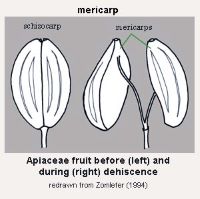 , sometimes drupe-like (splitting into 4, 1-seeded pyrenes or 2 pyrenespyrene:
, sometimes drupe-like (splitting into 4, 1-seeded pyrenes or 2 pyrenespyrene:
the hard inner portion of a drupe, consisting of a bony endocarp and an enclosed seed
, or not splitting), 0.5–45 mm long, globoseglobose:
3D shape—more or less spherical to tetrahedral, usually tereteterete:
to tetrahedral, usually tereteterete:
approximately circular in cross section; width and thickness approximately equal
 in transection, stylestyle:
in transection, stylestyle:
in a flower, the narrow and elongated part of the pistil between the stigma and the ovary; sometimes persisting in fruit persistent, rarely beakedbeak:
persistent, rarely beakedbeak:
a usually firm, terminal appendage, sometimes tapered (Rostrinucula), rarely winged, with one seed, rarely 2 or 4 seeds, enclosed by persistent perianthperianth:
(Rostrinucula), rarely winged, with one seed, rarely 2 or 4 seeds, enclosed by persistent perianthperianth:
collective term for calyx and corolla of a flower
 or calyxcalyx:
or calyxcalyx:
the outer whorl of the perianth; all the sepals of a flower . Pericarppericarp:
. Pericarppericarp:
fruit wall or fruit coat
black, brown (all shades), green, orange, red, or yellow, rarely dark blue or white, dulldull:
reflecting only a low proportion of incident light, with no apparent sheen or shinyshiny:
or shinyshiny:
uniformly reflecting a high proportion of incident light at all angles , hard or fleshy, glabrousglabrous:
, hard or fleshy, glabrousglabrous:
without hairs
or pubescentpubescent:
surface relief—bearing hairs
, may have glandularglandular:
surface relief—covered with small, raised secretory glands, regular or irregularly shaped, translucent or opaque, and maybe distinctly colored hairs or dots, often smooth or keeledkeel:
hairs or dots, often smooth or keeledkeel:
a longitudinal ridge, like the keel of a boat, formed by the lengthwise folding of a structure, such as a lemma or palea
 , sometimes ridgedridged:
, sometimes ridgedridged:
surface relief—raised, thick ridges, sharp edged or rounded, usually in a series that may cover the entire surface , pittedpitted:
, pittedpitted:
surface relief—surface with small depressions in which the areas between the hollows do not take on the appearance of a true reticular net , tuberculatetuberculate:
, tuberculatetuberculate:
surface relief—bearing small, warty, swelling, rounded, or variously shaped projections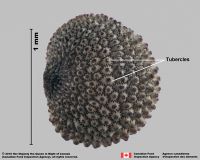 , papillatepapillate:
, papillatepapillate:
surface relief—bearing minute, distinct, broad-based projections, tapering to a rounded apex , reticulatereticulate:
, reticulatereticulate:
surface relief—netted, raised walls or concave grooves forming a net-like surface pattern with flat, concave, or convex interspaces , alveolatealveolate:
, alveolatealveolate:
surface relief—reticulated, honeycombed; ridges that intersect to form polygonal cells with a regular size and shape similar to a honeycomb , toothed or horned at apexapex:
, toothed or horned at apexapex:
the point farthest from the point of attachment, or the "tip" of an organ , sometimes mucilaginousmucilaginous:
, sometimes mucilaginousmucilaginous:
resembling mucilage; moist and sticky
. ElaiosomesElaiosome:
a lipid and protein-rich fleshy structure attached to some seeds and fruits, it attracts ants which then disperse the disseminule (e.g., caruncle in the Euphorbiaceae, the aril (outgrowth of the funiculus) in the Fabaceae)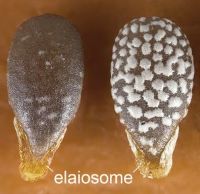 present in Lamium and Ajuga. Attachment scars usually visible, white, V-shaped, or two eyelike slits, 1/4 to as long as nutletnutlet:
present in Lamium and Ajuga. Attachment scars usually visible, white, V-shaped, or two eyelike slits, 1/4 to as long as nutletnutlet:
˜achene
.
Seeds C-shapedC-shaped:
2D-shape—semiannulate, curved into the shape of the letter 'C'
or oblongoblong:
2D shape—much longer than broad with nearly parallel sides, corners are rounded , triangulartriangular:
, triangulartriangular:
2D shape—three relatively straight sides with distinct corners; more angular than teardrop-shaped or tereteterete:
or tereteterete:
approximately circular in cross section; width and thickness approximately equal
 in transection, 0.5–40 mm long. Seed coat brown, dulldull:
in transection, 0.5–40 mm long. Seed coat brown, dulldull:
reflecting only a low proportion of incident light, with no apparent sheen or shinyshiny:
or shinyshiny:
uniformly reflecting a high proportion of incident light at all angles , tight, glabrousglabrous:
, tight, glabrousglabrous:
without hairs
, sometimes with crease between cotyledons and hypocotyl-radicle.
Embryo well developed, completely to partially filling seed coat, axileaxile:
on or of the axis
and centric, foliatefoliate:
appearing leaf-like
, usually straight, rarely bentbent:
(of embryo) embryo is bent at an acute, V-shaped angle with the ends close together and generally thick cotyledons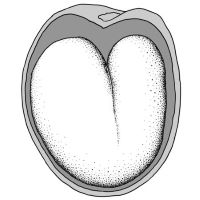 . Cotyledons investinginvesting:
. Cotyledons investinginvesting:
(of embryo) embryo is nearly or completely filling seed coat, straight, and axile and centric with spatulate cotyledons and covering the stalk for at least half its length; (of cotyledons) cotyledons spatulate and covering the stalk for at least half its length
or spatulatespatulate:
2D shape—like a spatula; rounded at the apex, with base long and tapered; (of embryo) embryo is straight and axile and centric with the cotyledons expanded to form the shape of a spatula or spoon; (of cotyledons) cotyledons expanded and wider than the stalk but not invested into the stalk .
.
Endosperm absent or scanty, if present fleshy and smooth.
Can be a common weed in lawns, wetlands, and gardens. It spreads by seed reproduction. Galeopsis tetrahit is a noxious weed in Alaska. Mesophaerum suaveo lenslens:
a mound, pad, or area of tissue situated near the hilum on seeds in the Mimosoideae and Caesalpinioideae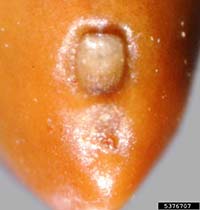 and Mesophaerum pectinatum are noxious weeds in Hawaii. Salvia virgata is a noxious weed in California. Salvia aethiopis is a noxious weed in California, Colorado, Nevada, and Utah. Stachys palustris is a noxious weed in Maine.
and Mesophaerum pectinatum are noxious weeds in Hawaii. Salvia virgata is a noxious weed in California. Salvia aethiopis is a noxious weed in California, Colorado, Nevada, and Utah. Stachys palustris is a noxious weed in Maine.
Aquarium & Pond Plants of the World tool includes descriptions and images of genera, which may be encountered.
| Fruit | |
| Type | schizocarpschizocarp: usually dry fruit splitting between two or more locules to form distinct, indehiscent, usually one seeded segments; fruit derived from a single, superior or inferior, compound ovary; compare to mericarp  , nut-like mericarpsmericarp: , nut-like mericarpsmericarp:a one-seeded section (carpel) of a schizocarp, as in Apiaceae fruits (compare schizocarp)  , or drupe-like fruits , or drupe-like fruits |
| Size range | 0.5–45 mm long |
| Shape(s) | globoseglobose: 3D shape—more or less spherical  , ellipsoidellipsoid: , ellipsoidellipsoid:3D shape—elliptic , fusiformfusiform: spindle-shaped; broadest at the middle and tapering at both ends  , oblongoblong: , oblongoblong:2D shape—much longer than broad with nearly parallel sides, corners are rounded  , claviformclaviform: , claviformclaviform:3D shape—club-shaped , obconicalobconical: 3D shape—inversely cone-shaped, with point of attachment at narrow end , boat-shaped, trigonoustrigonous: 3D shape—having three faces that meet at distinct angles; triangular in outline , tetrahedral, sometimes appearing lobed or deeply divided |
| Texture | hard, fleshy |
| Surface relief | smooth or keeledkeel: a longitudinal ridge, like the keel of a boat, formed by the lengthwise folding of a structure, such as a lemma or palea  , sometimes ridgedridged: , sometimes ridgedridged:surface relief—raised, thick ridges, sharp edged or rounded, usually in a series that may cover the entire surface  , pittedpitted: , pittedpitted:surface relief—surface with small depressions in which the areas between the hollows do not take on the appearance of a true reticular net  , tuberculatetuberculate: , tuberculatetuberculate:surface relief—bearing small, warty, swelling, rounded, or variously shaped projections  , papillatepapillate: , papillatepapillate:surface relief—bearing minute, distinct, broad-based projections, tapering to a rounded apex  , reticulatereticulate: , reticulatereticulate:surface relief—netted, raised walls or concave grooves forming a net-like surface pattern with flat, concave, or convex interspaces  , alveolatealveolate: , alveolatealveolate:surface relief—reticulated, honeycombed; ridges that intersect to form polygonal cells with a regular size and shape similar to a honeycomb  , toothed or horned at apexapex: , toothed or horned at apexapex:the point farthest from the point of attachment, or the "tip" of an organ  |
| Color(s) | black, brown (all shades), green, orange, red, yellow, rarely dark blue or white |
| Unique features | Usually brown or black, hard, 1-seeded nut-like mericarpsmericarp: a one-seeded section (carpel) of a schizocarp, as in Apiaceae fruits (compare schizocarp)  , often ridgedridged: , often ridgedridged:surface relief—raised, thick ridges, sharp edged or rounded, usually in a series that may cover the entire surface  or trigonoustrigonous: or trigonoustrigonous:3D shape—having three faces that meet at distinct angles; triangular in outline , with persistent stylesstyle: in a flower, the narrow and elongated part of the pistil between the stigma and the ovary; sometimes persisting in fruit  and visible attachment scars. Scars white, V-shaped, or two eye-like slits, 1/4 to a long as nutletsnutlet: and visible attachment scars. Scars white, V-shaped, or two eye-like slits, 1/4 to a long as nutletsnutlet:˜achene . Sometimes drupaceous with 1 or more pyrenespyrene: the hard inner portion of a drupe, consisting of a bony endocarp and an enclosed seed . |
| Seed | |
| Size range | less than 40 mm |
| Shape(s) | C-shapedC-shaped: 2D-shape—semiannulate, curved into the shape of the letter 'C' , oblongoblong: 2D shape—much longer than broad with nearly parallel sides, corners are rounded  |
| Color(s) | brown |
| Other | |
| Embryo | well developed, completely to partially filling seed coat, axileaxile: on or of the axis and centric, foliatefoliate: appearing leaf-like , usually straight, rarely bentbent: (of embryo) embryo is bent at an acute, V-shaped angle with the ends close together and generally thick cotyledons  . Cotyledons investinginvesting: . Cotyledons investinginvesting:(of embryo) embryo is nearly or completely filling seed coat, straight, and axile and centric with spatulate cotyledons and covering the stalk for at least half its length; (of cotyledons) cotyledons spatulate and covering the stalk for at least half its length or spatulatespatulate: 2D shape—like a spatula; rounded at the apex, with base long and tapered; (of embryo) embryo is straight and axile and centric with the cotyledons expanded to form the shape of a spatula or spoon; (of cotyledons) cotyledons expanded and wider than the stalk but not invested into the stalk  . . |
| Nutritive tissue | endosperm absent or scanty, if present fleshy and smooth. |
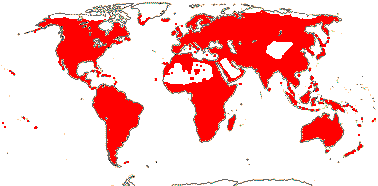
Distribution map courtesy of Angiosperm Phylogeny Website.
Bingham et al. 2021+Bingham et al. 2021+:
Bingham MG, Willeman A, Wursten BT, Ballings P, and Hyde MA. 2021. Flora of Zambia. Accessed January 2021–April 2024. URL: https://www.zambiaflora.com; Flora of North America Editorial Committee 1993+Flora of North America Editorial Committee 1993+:
Flora of North America Editorial Committee, eds. 1993+. Flora of North America North of Mexico [Online]. 22+ vols. Flora of North America Association, New York and Oxford. Accessed January-March 2024. URL: http://beta.floranorthamerica.org.; Keng 1978Keng 1978:
Keng H. 1978. Labiatae. In: Flora Malesiana, Steenis CGGJ van and Steenis-Kruseman MJ van, eds, Ser 1., Vol 8, part 3. Noordhoff-Kolff, Djakarta.; Kirkbride et al. 2006Kirkbride et al. 2006:
Kirkbride JH, Jr, Gunn CR, and Dallwitz MJ. 2006. Family guide for fruits and seeds, vers. 1.0. Accessed September 2020-January 2022. URL: https://nt.ars-grin.gov/seedsfruits/keys/frsdfam/index.cfm .; Kubitzki et al. 1990+Kubitzki et al. 1990+:
Kubitzki K et al., eds. 1990+. The families and genera of vascular plants. 7+ vols. Berlin etc.; Mabberley and De Kok 2004Mabberley and De Kok 2004:
Mabberley DJ and De Kok RPJ. 2004. Labiatae. Flore de la Nouvelle-Calédonie et Dépendances 25: 20&-141. Muséum National d’Histoire Naturelle, Paris.; Paton et al. 2009Paton et al. 2009:
Paton AJ, Bramley G, Ryding O, Polhill RM, Harvey YB, Iwarsson M, Willis F, Phillipson PB, Balkwill K, Lukhoba CW, Otieno DF, and Harley RM. 2009. Lamiaceae (Labiatae). In: Flora of Tropical East Africa, Beentje H, Ghazanfar SA, and Polhill RM, eds. Royal Botanic Gardens, Kew, UK. 435 pp.; Takhtajan 2009Takhtajan 2009:
Takhtajan A. 2009. Flowering plants: Second edition. Springer Nature, Switzerland. 871 pp.; USDA 1980USDA 1980:
United States Dept. of Agriculture (USDA). 1980. Major weed family identification guide. Hyattsville Md, United States ; Zhengyi et al. 2004+Zhengyi et al. 2004+:
Zhengyi W, Raven PH, and Deyuan H. 2004+. Flora of China [online]. 25 vols. Science Press, Beijing China & Missouri Botanical Garden, St. Louis USA. Accessed January–March 2024. http://flora.huh.harvard.edu/china/; Zhao et al. 2021Zhao et al. 2021:
Zhao F, Chen YP, Salmaki Y, Drew BT, Wilson TC, Scheen A-C, Celep F, Bräuchler C, Bendiksby M, Wang Q, Min D-Z, Peng H, Olmstead RG, Li Bo, and Xiang C-L. 2021. An updated tribal classification of Lamiaceae based on plastome phylogenomics. BMC Biology 19(2). https://doi.org/10.1186/s12915-020-00931-z
*The number of genera and species is based on Christenhusz and Byng 2016Christenhusz and Byng 2016:
Christenhusz MJM and Byng JW. 2016. The number of known plant species in the world and its annual increase. Phytotaxa 261 (3): 201-217. https://doi.org/10.11646/phytotaxa.261.3.1, which may differ from the number of genera in GRIN-Global.